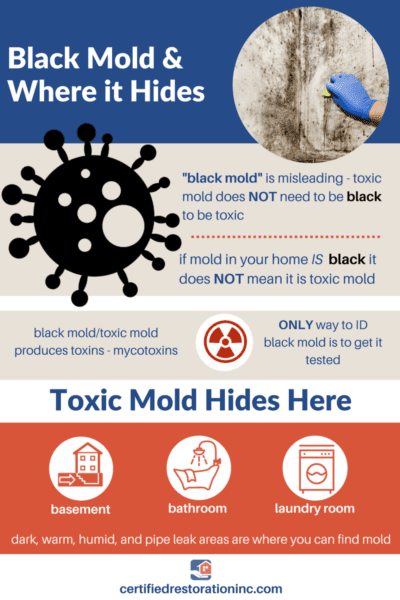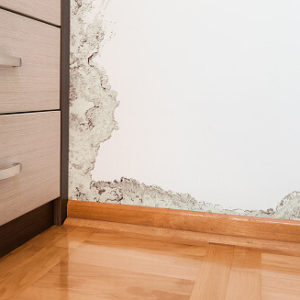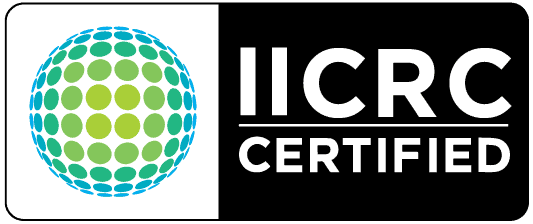A Property Owner’s Guide to Black Mold Risks, Identification, and Remediation
For many property owners, discovering black mold’s telltale dark specks can trigger a serious concern. Known as “toxic mold,” black mold can indicate deeper issues within your property. Beyond structural damage, it poses significant health risks and is notoriously difficult to identify and remediate. This guide will help you navigate the complexities of black mold, covering the following key points:
– Black mold poses serious health risks and can be challenging to remove.
– It typically grows on materials like drywall, carpet, insulation, and sub-flooring, particularly in warm, damp areas such as basements, bathrooms, and laundry rooms.
– The primary cause of moisture that fosters black mold growth is water damage from leaks, condensation, or flooding.
– Symptoms of exposure can range from mild allergies to serious neurological issues.
– Engaging professionals is crucial for safe and effective black mold remediation.
What is Black Mold?
Black mold, or Stachybotrys chartarum, is a type of fungus that can produce harmful toxins, leading to various health issues in humans. It thrives on materials that have absorbed moisture, such as drywall and carpeting, primarily caused by leaks or flooding. It’s important to note that black mold can vary in color, appearing greenish-black, gray, or brown.

How to Identify Black Mold
Stachybotrys is usually dark and has a musty, earthy odor. It often appears in ring-like formations and may feature flecks of orange or white. If you suspect mold in your property, it’s crucial to have it tested by a professional mold inspection service. They will take air and surface samples to analyze for mold spores, providing recommendations for any necessary remediation.
Where Does Black Mold Appear?
Toxic mold often emerges in warm, damp locations. Common areas include:
– Basements and Crawl Spaces: Often susceptible to small leaks.
– Bathrooms and Laundry Rooms: Poor ventilation can foster moisture buildup.
– HVAC Systems: Dark, dust-filled environments provide ideal conditions for mold growth, potentially circulating spores throughout your home.
Health Risks of Black Mold
Black mold exposure can lead to numerous health issues, including:
Mental and Neurological Symptoms
– Confusion – Anxiety
– Mood swings
– Difficulty concentrating
Respiratory Symptoms
– Difficulty breathing
– Asthma attacks
– Sore throat
– Coughing
Circulatory System Symptoms

– Irregular heartbeat
– Internal bleeding
Vision Problems
– Eye irritation
– Blurry vision
Skin Problems
– Rashes
– Inflammation
If you experience any of these symptoms and suspect black mold, immediate action is essential.
How to Prevent Black Mold Growth
Preventing black mold starts with addressing moisture issues. Here are some tips:
– Install Water Leak Detectors: Place these around toilets, water heaters, and appliances to catch leaks before they lead to mold.
– Regular Inspections: Check for dampness and existing mold growth in common problem areas, such as basements and bathrooms.
– Use Dehumidifiers: Keeping humidity levels below 50% can inhibit mold growth.
How to Get Rid of Black Mold

While DIY solutions exist, black mold is toxic and challenging to eliminate entirely. It’s best to hire professionals for effective remediation. They have the expertise and equipment to ensure safe removal, minimizing health risks and preventing future outbreaks.
Benefits of Professional Mold Removal Services
– Reduced Risk of Exposure: Professionals use proper techniques and equipment to keep you safe during the cleanup.
– Thorough Cleanup: Experts ensure complete removal of black mold and its sources.
– Quick Response Time: Professionals can address the issue efficiently, applying best practices.
– Future Prevention: Professionals can identify at-risk areas in your property, recommending solutions to prevent recurrence.
If you suspect black mold in your property, contact Certified Restoration immediately. Our experienced San Diego mold remediation specialists can efficiently remove mold infestations, ensuring your home is safe for you and your family. We provide 24/7 water damage restoration services in San Diego, so don’t hesitate to reach out if you notice signs of mold. Your health and safety are our top priority!





